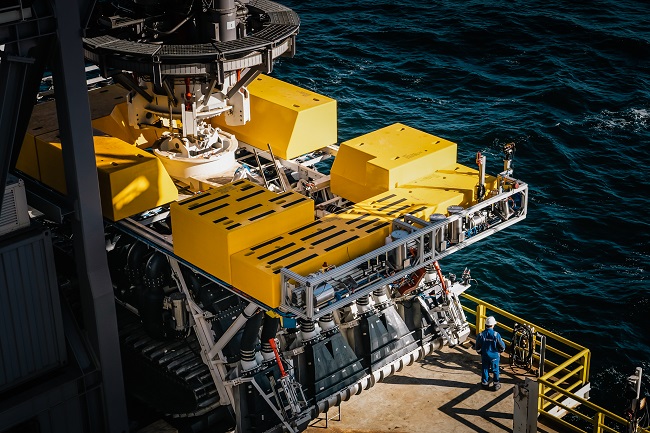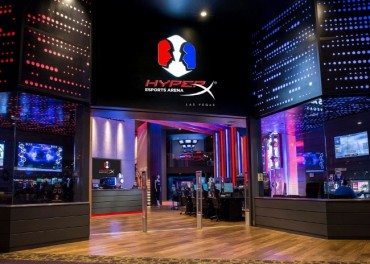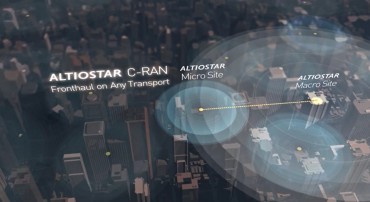
The Allseas-designed pilot collector vehicle awaits deployment from the Hidden Gem during the first integrated system trials in the Clarion Clipperton Zone of the Pacific Ocean since the 1970s.
NEW YORK, Nov. 14 (Korea Bizwire) — TMC the metals company Inc. (Nasdaq: TMC) (“TMC” or the “Company”), an explorer of the world’s largest estimated undeveloped source of critical battery metals, today announced that its subsidiary NORI and offshore partner Allseas have successfully concluded the first integrated system test in the Clarion Clipperton Zone of the Pacific Ocean since the 1970s, achieving all significant pilot milestones while collecting approximately 4,500 tonnes of seafloor polymetallic nodules. Over 3,000 tonnes were transported up a 4.3km-long riser system to the surface production vessel, Hidden Gem, while the additional 1,500 tonnes of nodules were purposely left behind on the seafloor as part of the trials.
Following initial pilot system commissioning tests, the dedicated team of 130 crew and engineers aboard the Hidden Gem conducted a series of production runs in NORI-D test area to assess the system’s endurance prior to further development into a small-scale commercial system. Driving the pilot nodule collector over 80 kilometers, Allseas engineers put the system through a series of tests achieving a sustained production rate of 86.4 tonnes per hour, roughly equivalent to transporting the mass of 40 Tesla Model S vehicles up the 4.3-km riser pipe every sixty minutes. The pilot system is expected to be scaled up to include additional collector heads and a wider diameter riser pipe in preparation for NORI’s Project Zero, which will target a production rate of over 200 tonnes per hour.
Concurrently, aboard a dedicated monitoring vessel, marine experts and academic scientists conducted the first monitoring program of an integrated pilot collector system test. The team used remotely operated vehicles (ROVs) and autonomous underwater vehicles (AUVs) to survey, monitor and sample the sediment plumes generated by collector operations on the seafloor as well as the mid-water discharge of water from the riser system used to transport nodules from seafloor to the Hidden Gem. The team deployed an array of over 50 subsea sensors on seafloor landers and mid-water moorings to continually monitor sediment plumes and noise generated by the nodule collection operations. The ongoing monitoring program will continue to survey environmental impacts and produce valuable scientific data after the conclusion of the collector system test.
Gerard Barron, CEO & Chairman of The Metals Company said: “We believe in making decisions based on data and evidence, not speculation and sentiment. This pilot collection system trial and monitoring campaign is the single most important milestone in de-risking the NORI-D project and establishing actual data on the environmental impact profile of potential nodule collection operations and improvements we can make going forward.”
He added: “I’d like to thank the teams aboard all three vessels involved in this complex pilot test and monitoring campaign who have worked tirelessly—some for months—co-ordinating and solving problems together offshore. Hidden Gem is now heading back to port with over 3,000 tonnes of nodules in her hold but the post-collection survey work is still ongoing until the end of the year. We look forward to the completion of this important work and the opportunity to share the data and its implications with the global community as soon as possible.”
With the technology trials complete, the marine research teams will remain on-site to recover the landers and moorings deployed for the collector test monitoring program and will undertake post-collection surveys to compare the status of the seafloor environment before and after the test. Once complete, the collection system test monitoring program will represent the single largest simultaneous environmental impact monitoring study ever conducted in the CCZ. The data collected, together with many terabytes of existing baseline data collected by NORI throughout 16 offshore campaigns, will form the basis of NORI’s application to the International Seabed Authority for an exploitation contract, which the Company expects to be ready for submission in the second half of 2023.
TMC and NORI expect that the findings from the rich data gathered during the trials will be published in scientific literature in the next year, in what is expected to be a significant expansion of our understanding of the deep-sea ecosystem in the CCZ where 17 of the 19 nodule exploration contracts awarded by the ISA are located.
In September 2022, NORI announced that it received the ISA’s recommendation to commence its pilot nodule collection system trials in the CCZ after its review of the Collector Test Environmental Impact Statement (EIS) and Collector Test Environmental Monitoring and Management Plan (EMMP). While several ISA contractors including BGR (Germany), GSR (Belgium) and NIOT (India) have successfully conducted trials of prototype nodule collectors in recent years, the conclusion of NORI’s tests marks the first time an integrated nodule collection system — including a riser system — has been tested in the Clarion Clipperton Zone since the 1970s, when oil, gas, mining and industrial majors including Shell, BP, Rio Tinto (Kennecott), US Steel, INCO (Vale) and Sumitomo successfully conducted pilot test work, collecting ~2,000 tonnes of nodules.
In March 2022, NORI and Allseas agreed that the pilot nodule collection system would be upgraded by Allseas to a commercial system with a targeted production capacity of 1.3 million tonnes of wet nodules per year and expected production readiness by Q4 2024.
About The Metals Company
The Metals Company is an explorer of lower-impact battery metals from seafloor polymetallic nodules, on a dual mission: (1) supply metals for the clean energy transition with the least possible negative environmental and social impact and (2) accelerate the transition to a circular metal economy. The Company through its subsidiaries holds exploration and commercial rights to three polymetallic nodule contract areas in the Clarion Clipperton Zone of the Pacific Ocean regulated by the International Seabed Authority and sponsored by the governments of Nauru, Kiribati and the Kingdom of Tonga.
More Info
Media | media@metals.co
Investors | investors@metals.co
Forward Looking Statements
Certain statements made in this press release are not historical facts but are forward-looking statements for purposes of the safe harbor provisions under The Private Securities Litigation Reform Act of 1995. Forward-looking statements generally are accompanied by words such as “believe,” “may,” “will,” “estimate,” “continue,” “anticipate,” “intend,” “expect,” “should,” “would,” “plan,” “predict,” “potential,” “seem,” “seek,” “future,” “outlook” and similar expressions that predict or indicate future events or trends or that are not statements of historical matters. The forward-looking statements contained in this press release include, without limitation, statements regarding the publication of data from monitoring of the pilot collection system testing in the CCZ, TMC’s pilot collection testing in the CCZ, and the timing and content of an application to the ISA for an exploitation contract as well as the design, use and accuracy of any technology developed by TMC and its partners, agents and/or service providers to support its operations. These forward-looking statements involve significant risks and uncertainties that could cause the actual results to differ materially from those discussed in the forward-looking statements. Most of these factors are outside TMC’s control and are difficult to predict. Factors that may cause such differences include, but are not limited to: the successful and timely completion of the ongoing pilot testing of TMC’s collection system in the CCZ; regulatory uncertainties and the impact of government regulation and political instability on TMC’s resource activities; changes to any of the laws, rules, regulations or policies to which TMC is subject; the impact of extensive and costly environmental requirements on TMC’s operations; environmental liabilities; the impact of polymetallic nodule collection on biodiversity in the CCZ and recovery rates of impacted ecosystems; TMC’s ability to develop minerals in sufficient grade or quantities to justify commercial operations; the lack of development of seafloor polymetallic nodule deposit; uncertainty in the estimates for mineral resource calculations from certain contract areas and for the grade and quality of polymetallic nodule deposits; risks associated with natural hazards; uncertainty with respect to the specialized treatment and processing of polymetallic nodules that TMC may recover; risks associated with collection, development and processing polymetallic nodules; risks associated with TMC’s limited operating history; the impact of the COVID-19 pandemic; risks associated with TMC’s intellectual property and the validity, use and ownership of any new technology or intellectual property subsisting therein; TMC’s ability to raise additional funds; and other risks and uncertainties indicated from time to time in the Company’s Form 10-K, dated and filed with the U.S. Securities and Exchange Commission (SEC) on March 25, 2022 as well as the Company’s Form 10-Q filed with the SEC on August 15, 2022, including those under “Risk Factors” therein, and in TMC’s other future filings with the SEC. TMC cautions that the foregoing list of factors is not exclusive. TMC cautions readers not to place undue reliance upon any forward-looking statements, which speak only as of the date made. TMC does not undertake or accept any obligation or undertaking to release publicly any updates or revisions to any forward-looking statements to reflect any change in its expectations or any change in events, conditions, or circumstances on which any such statement is based except as required by law.
Photos accompanying this announcement are available at
https://www.globenewswire.com/NewsRoom/AttachmentNg/4fcb8316-68ec-4b40-935d-d755e8ec6f29
https://www.globenewswire.com/NewsRoom/AttachmentNg/f4344afd-acde-49aa-af79-5064f934c5fc
https://www.globenewswire.com/NewsRoom/AttachmentNg/51bf9f27-f220-46c4-8a57-4178ff98b193
https://www.globenewswire.com/NewsRoom/AttachmentNg/07938625-16e7-420e-814c-a38dbf33a455
Source: TMC the metals company Inc. via GLOBE NEWSWIRE







